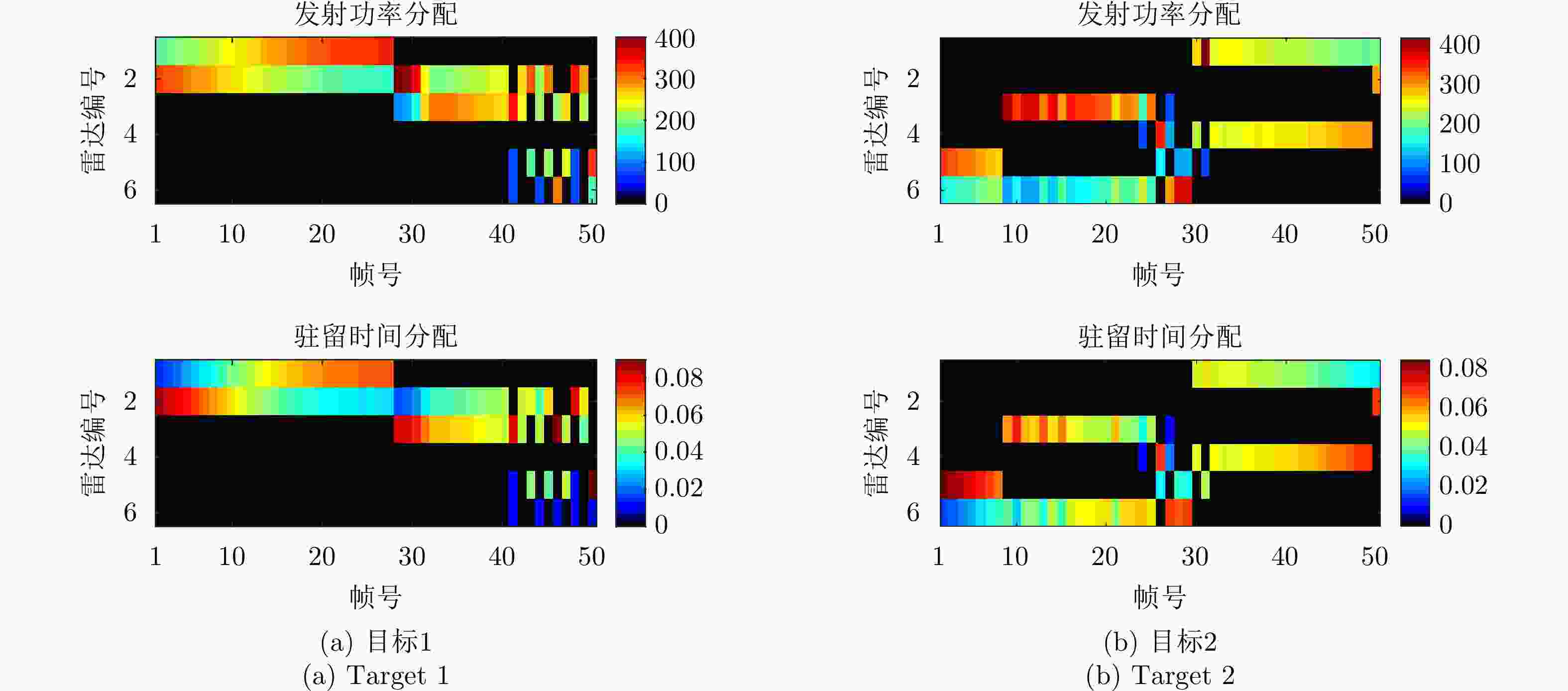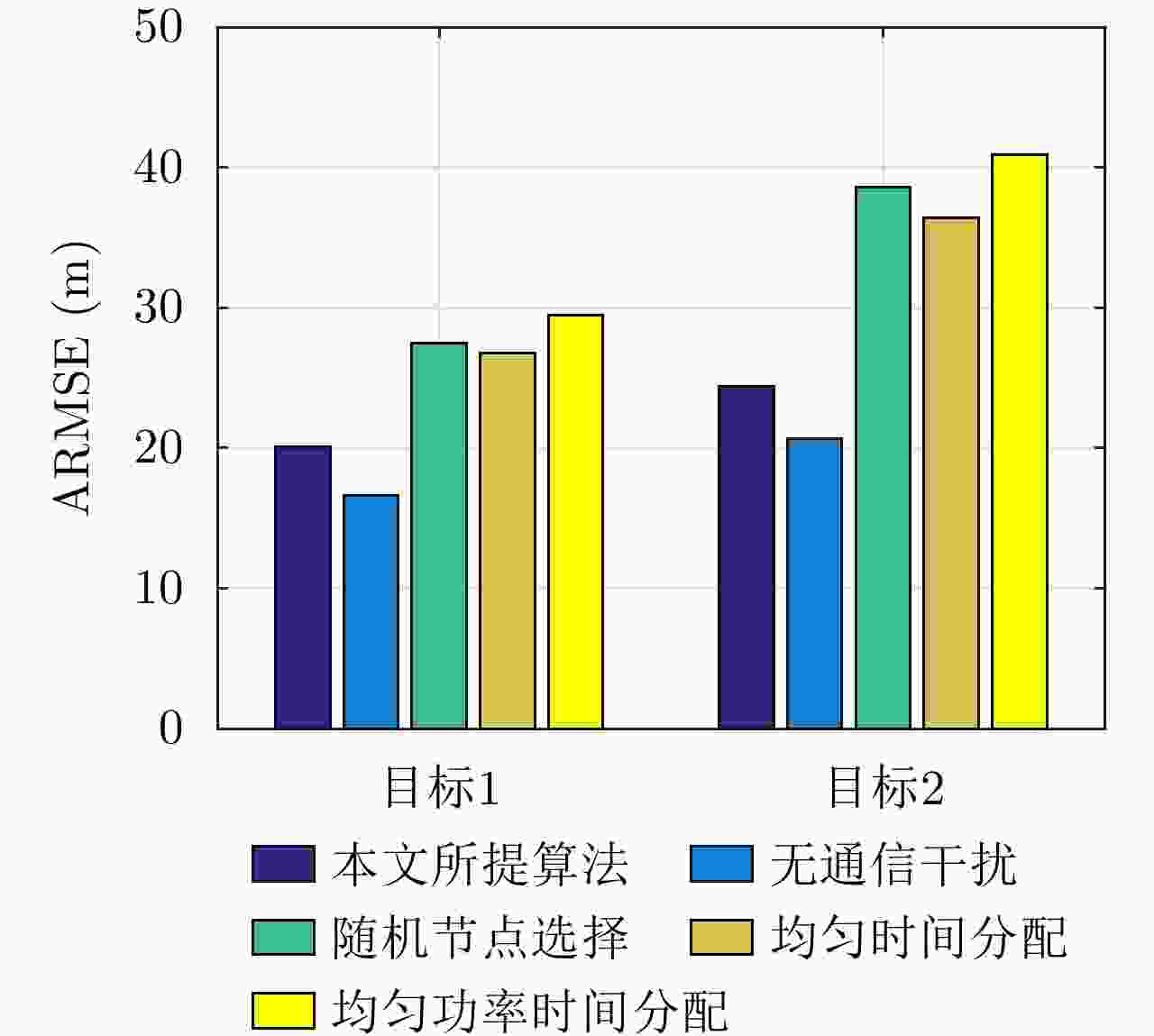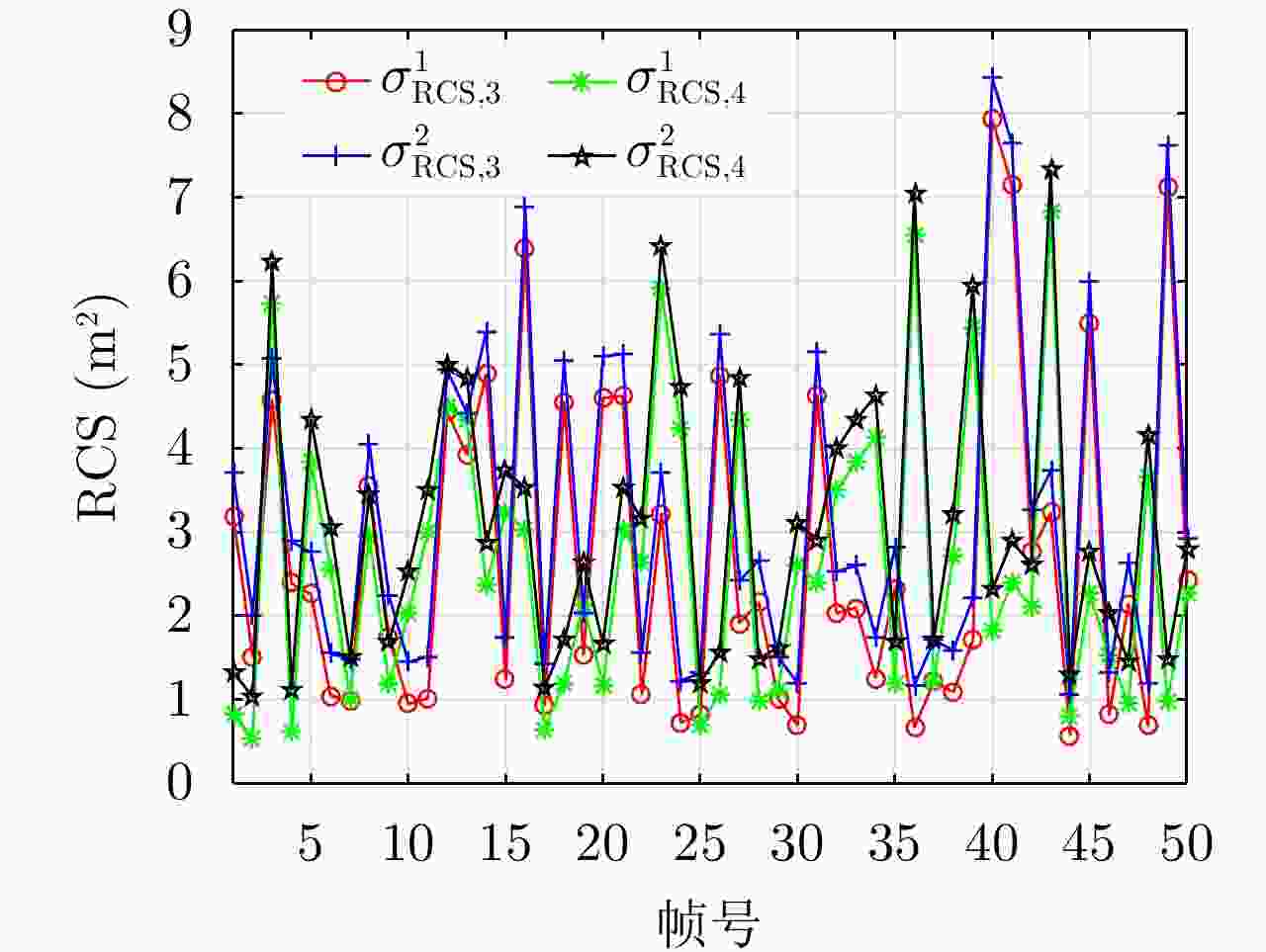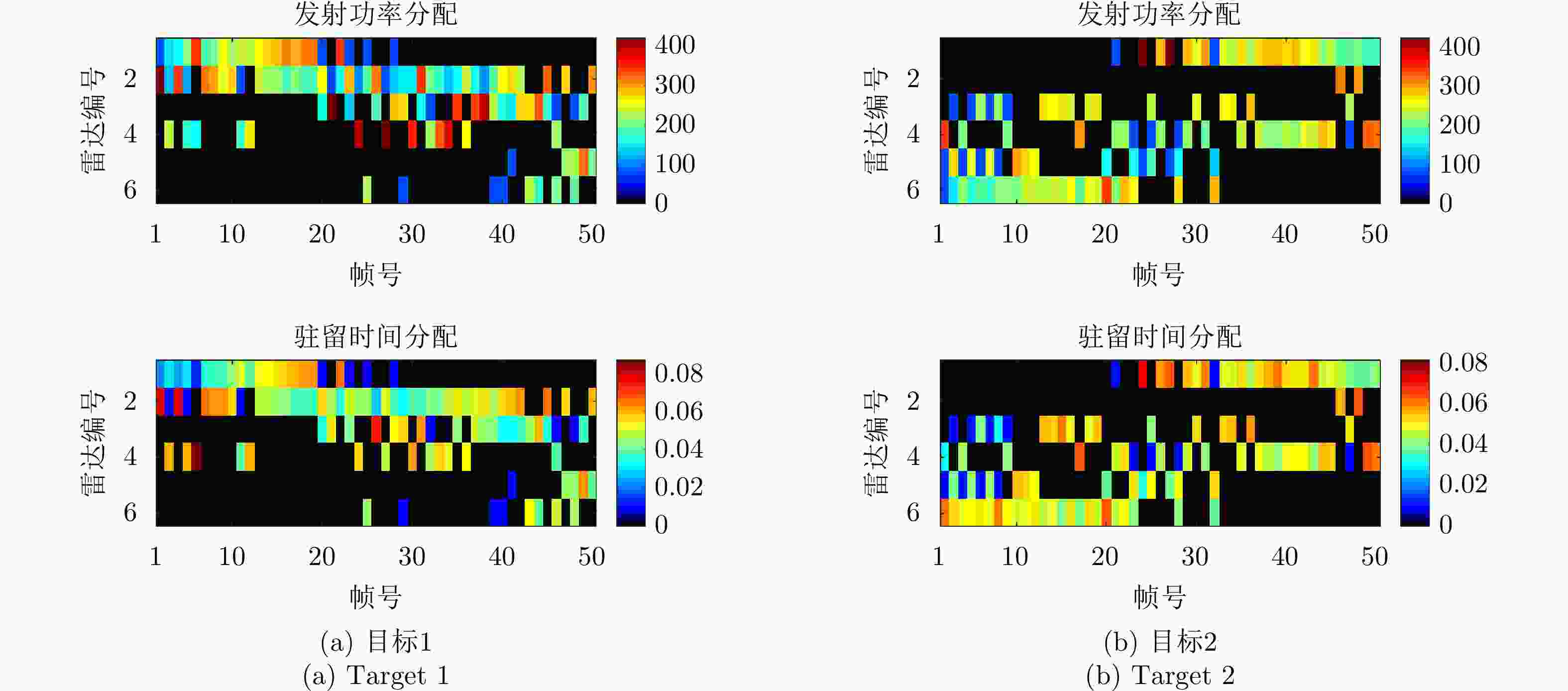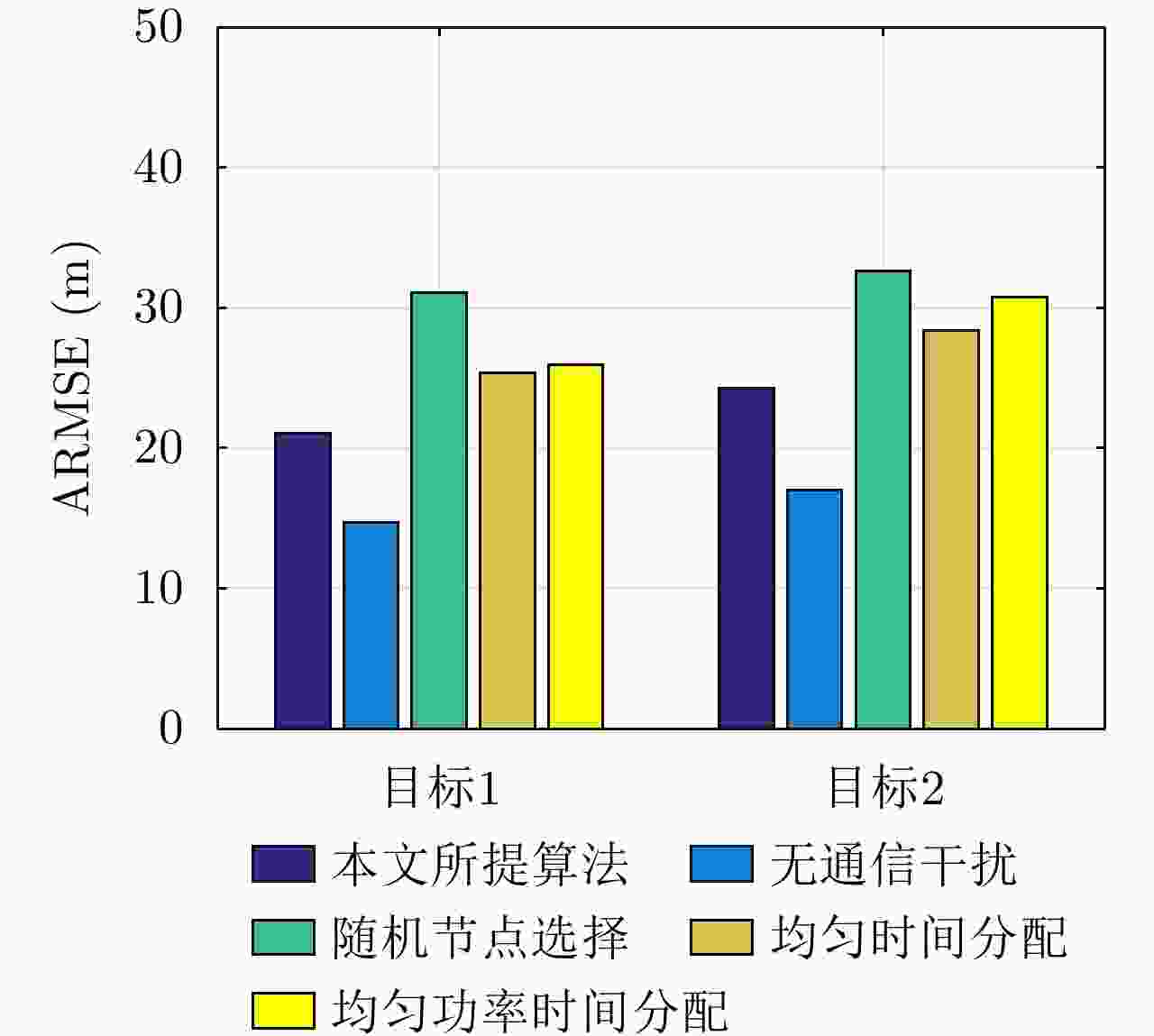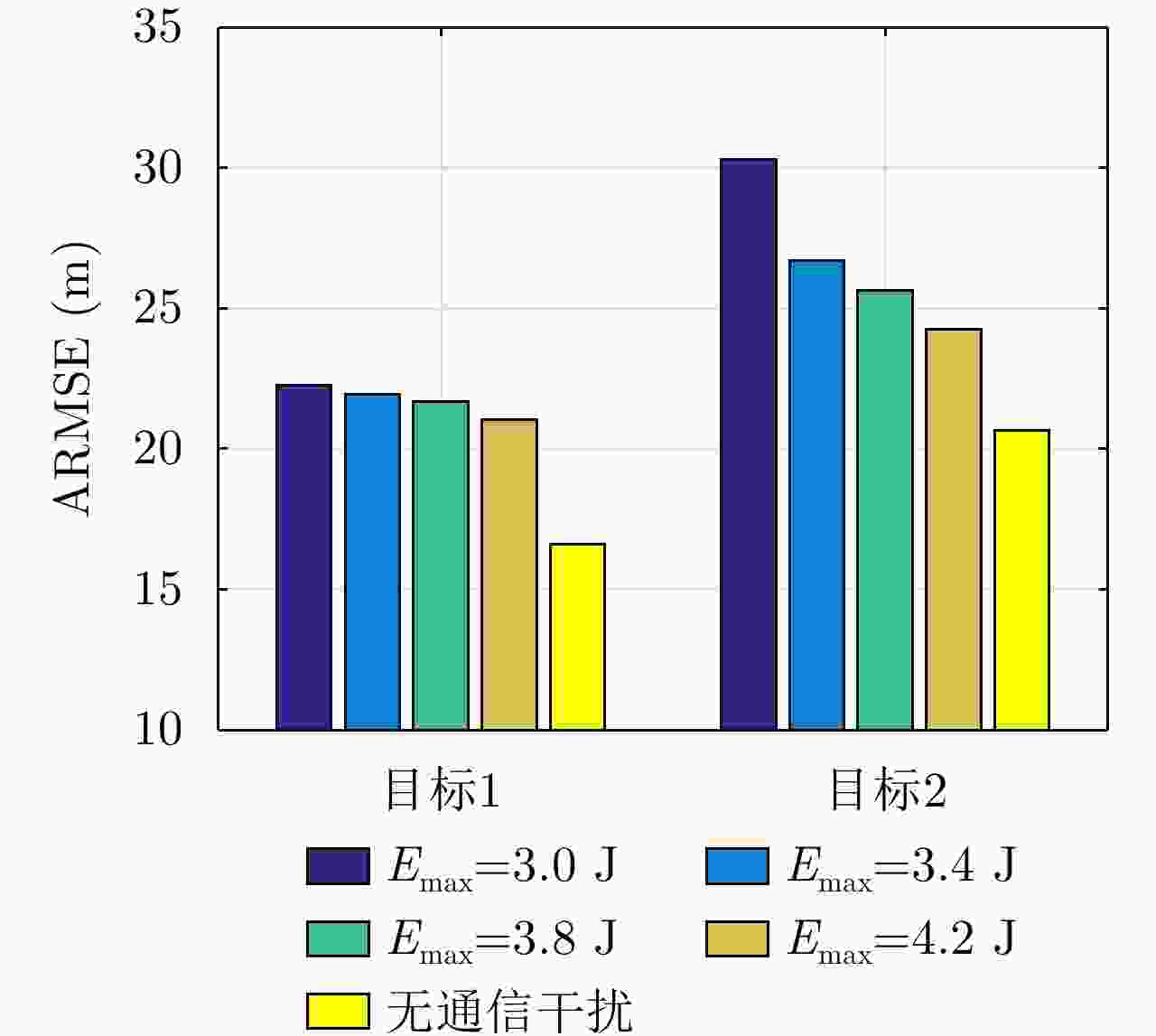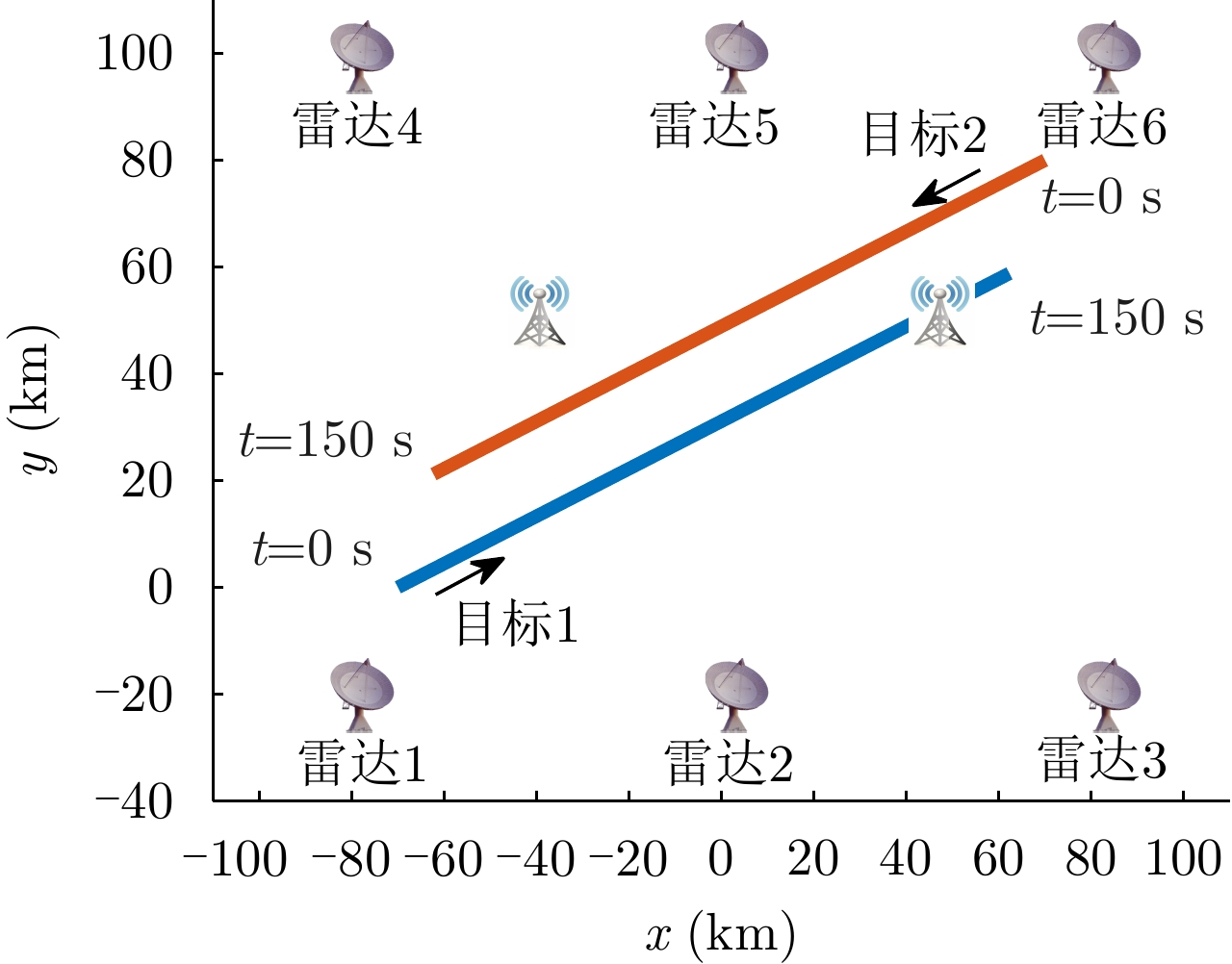Joint Transmit Power and Dwell Time Allocation for Multitarget Tracking in Radar Networks under Spectral Coexistence
-
摘要: 该文针对频谱共存环境下多目标跟踪资源分配问题,提出了组网雷达功率时间联合优化算法。首先,推导了包含雷达节点选择、发射功率和驻留时间等射频辐射参数的预测贝叶斯克拉默-拉奥下界(BCRLB),以此作为多目标跟踪精度的衡量指标;在此基础上,以最小化多目标跟踪BCRLB为优化目标,以满足给定的组网雷达射频资源和预先设定的通信基站最大可容忍干扰能量阈值为约束条件,建立了频谱共存下面向多目标跟踪的组网雷达功率时间联合优化分配模型,对雷达节点选择、发射功率和驻留时间进行自适应联合优化配置;然后,针对上述优化问题,采用两步分解法将其分解为多个子凸问题,并结合半正定规划(SDP)算法和循环最小化算法进行求解。仿真结果表明,与现有算法相比,所提算法能够在保证通信基站正常工作的条件下,有效提高组网雷达的多目标跟踪精度。Abstract: For the resource allocation problem of multitarget tracking in a spectral coexistence environment, this study proposes a joint transmit power and dwell time allocation algorithm for radar networks. First, the predicted Bayesian Cramér-Rao Lower Bound (BCRLB) with the variables of radar node selection, transmit power and dwell time is derived as the performance metric for multi-target tracking accuracy. On this basis, a joint optimization model of transmit power and dwell time allocation for multitarget tracking in radar networks under spectral coexistence is built to collaboratively optimize the radar node selection, transmit power and dwell time of radar networks, This joint optimization model aims to minimize the multitarget tracking BCRLB while satisfying the given transmit resources of radar networks and the predetermined maximum allowable interference energy threshold of the communication base station. Subsequently, for the aforementioned optimization problem, a two-step decomposition method is used to decompose it into multiple subconvex problems, which are solved by combining the Semi-Definite Programming (SDP) and cyclic minimization algorithms. The simulation results showed that, compared with the existing algorithms, the proposed algorithm can effectively improve the multitarget tracking accuracy of radar networks while ensuring that the communication base station works properly.
-
Key words:
- Resource allocation /
- Radar networks /
- Multitarget tracking /
- Spectral coexistence
-
算法 1 频谱共存下面向多目标跟踪的组网雷达功率时间
联合优化算法求解流程Alg. 1 Solution flow of joint transmit power and dwell time allocation for multitarget tracking in radar networks
under spectral coexistence初始化:$ \Im \left( 0 \right) $为给定常数,定义发射功率和驻留时间初始值
$\hat P_{n,k}^q$, $\hat T_{n,k}^q$;步骤1 选定运动目标q,求解SDP问题(18),求出k时刻雷达权重
矢量$ {\boldsymbol{\alpha }}_k^q $,获得$ \left( {{\partial _{\max }} - 1} \right) $种雷达节点选择备选方案。步骤2 对于 $s = 1,2, \cdots ,({\partial _{\max } } - 1 )$: 1. 设定方案s选择的雷达节点权重系数$\bar \alpha _{n,k,s}^q = 1$,其余节点
权重系数均初始化为0;2.求解SDP问题(19),得到雷达节点选择$ {\boldsymbol{\alpha }}_{k,s}^q $、发射功率
$ {\boldsymbol{P}}_{k,s}^q $、驻留时间$ {\boldsymbol{T}}_{k,s}^q $以及目标跟踪误差$ \Im _{k,s}^q $;步骤3 选取步骤2所有方案中的最小跟踪误差$ \Im _k^q $及其对应雷达节
点选择方案和资源分配方案作为备选方案;如果$\left| {\Im _k^q - \Im \left( 0 \right)} \right| \le \varepsilon $且$\Im _k^q < \Im \left( 0 \right)$:选取$ \Im _k^q $和其对应的雷达
节点权重集合、发射功率集合和驻留时间集合作为k时刻跟踪
目标q的资源分配方案;否则:$\Im \left( 0 \right) = \min \left( {\Im \left( 0 \right),\Im _k^q} \right)$,并保存其对应的雷达节点选
择和资源分配方案,跳转至步骤1;步骤4 输出原问题(17)的最终雷达节点选择、发射功率、驻留时
间结果$ {\boldsymbol{\alpha }}_k^q $, $ {\boldsymbol{P}}_k^q $, $ {\boldsymbol{T}}_k^q $,并确定下一个跟踪目标,跳转至步骤1,直
到所有的运动目标跟踪方案都完成优化。表 1 仿真参数设置
Table 1. Simulation parameter settings
参数 数值 参数 数值 $ {G_{\text{t}}} $ $ 36{\text{ dB}} $ $ \beta $ $ 1{\text{ MHz}} $ $ {G_{\text{r}}} $ $ 35{\text{ dB}} $ $ {F_{\text{r}}} $ $ 3{\text{ dB}} $ $ {G_{{\text{RP}}}} $ $ 45 $ k $1.38 \times {10^{ - 23} }\;{ {\text{J} } \mathord{\left/ {\vphantom { {\text{J} } {\text{K} } } } \right. } {\text{K} } }$ $ {P_{\min }} $ $ 100{\text{ W}} $ $ {P_{\max }} $ $ 600{\text{ W}} $ ${T_{ {\text{min} } } }$ $ 0.01{\text{ s}} $ $ {T_{\max }} $ $ 0.08{\text{ s}} $ $ {P_{{\text{total}}}} $ $ 700{\text{ W}} $ $ {T_{{\text{total}}}} $ $ 0.1{\text{ s}} $ -
[1] SKOLNIK M I, 左群声, 徐国良, 马林, 等译. 雷达系统导论[M]. 3版. 北京: 电子工业出版社, 2014: 191–199.SKOLNIK M I, ZUO Qunsheng, XU Guoliang, MA Lin, et al. translation. Introduction to Radar Systems[M]. 3rd ed. Beijing: Publishing House of Electronics Industry, 2014: 191–199. [2] 时晨光, 周建江, 汪飞, 等. 机载雷达组网射频隐身技术[M]. 北京: 国防工业出版社, 2019: 5–12.SHI Chenguang, ZHOU Jianjiang, WANG Fei, et al. Radio Frequency Stealth Technology for Airborne Radar Network[M]. Beijing: National Defense Industry Press, 2019: 5–12. [3] 陈小龙, 薛永华, 张林, 等. 机载雷达系统与信息处理[M]. 北京: 电子工业出版社, 2021: 33–41.CHEN Xiaolong, XUE Yonghua, ZHANG Lin, et al. Airborne Radar System and Information Processing[M]. Beijing: Publishing House of Electronics Industry, 2021: 33–41. [4] 刘凡, 袁伟杰, 原进宏, 等. 雷达通信频谱共享及一体化: 综述与展望[J]. 雷达学报, 2021, 10(3): 467–484. doi: 10.12000/JR20113LIU Fan, YUAN Weijie, YUAN Jinhong, et al. Radar-communication spectrum sharing and integration: Overview and prospect[J]. Journal of Radars, 2021, 10(3): 467–484. doi: 10.12000/JR20113 [5] 韩长喜, 董金良, 邓大松, 等. 2021年雷达技术态势与发展趋势[J]. 中国电子科学研究院学报, 2022, 17(4): 329–334. doi: 10.3969/j.issn.1673-5692.2022.04.004HAN Changxi, DONG Jinliang, DENG Dasong, et al. Current progress and development trend of radar system and technology in 2021[J]. Journal of CAEIT, 2022, 17(4): 329–334. doi: 10.3969/j.issn.1673-5692.2022.04.004 [6] 时晨光, 董璟, 周建江, 等. 飞行器射频隐身技术研究综述[J]. 系统工程与电子技术, 2021, 43(6): 1452–1467. doi: 10.12305/j.issn.1001-506X.2021.06.02SHI Chenguang, DONG Jing, ZHOU Jianjiang, et al. Overview of aircraft radio frequency stealth technology[J]. Systems Engineering and Electronics, 2021, 43(6): 1452–1467. doi: 10.12305/j.issn.1001-506X.2021.06.02 [7] 王峰, 李培, 徐锋. 新一代雷达电磁空间深蓝博弈技术需求分析[J]. 中国电子科学研究院学报, 2021, 16(12): 1195–1200, 1223. doi: 10.3969/j.issn.1673-5692.2021.12.003WANG Feng, LI Pei, and XU Feng. Demand analysis of deep blue game in electromagnetic space for new generation radar[J]. Journal of CAEIT, 2021, 16(12): 1195–1200, 1223. doi: 10.3969/j.issn.1673-5692.2021.12.003 [8] QIAN Junhui, LOPS M, ZHENG Le, et al. Joint system design for coexistence of MIMO radar and MIMO communication[J]. IEEE Transactions on Signal Processing, 2018, 66(13): 3504–3519. doi: 10.1109/TSP.2018.2831624 [9] ZHENG Le, LOPS M, and WANG Xiaodong. Adaptive interference removal for uncoordinated radar/communication coexistence[J]. IEEE Journal of Selected Topics in Signal Processing, 2018, 12(1): 45–60. doi: 10.1109/jstsp.2017.2785783 [10] 鲁彦希. 网络化雷达协同探测与资源管理研究[D]. [博士论文], 电子科技大学, 2020.LU Yanxi. Research on collaborative sensing and resource management of networked radar[D]. [Ph. D. dissertation], University of Electronic Science and Technology of China, 2020. [11] SU Yang, CHENG Ziyang, HE Zishu, et al. Communication-awareness adaptive resource scheduling strategy for multiple target tracking in a multiple radar system[J]. IET Signal Processing, 2022, in press. [12] WU Linlong, MISHRA K V, SHANKAR M R B, et al. Resource allocation in heterogeneously-distributed joint radar-communications under asynchronous Bayesian tracking framework[J]. IEEE Journal on Selected Areas in Communications, 2022, 40(7): 2026–2042. doi: 10.1109/JSAC.2022.3157371 [13] LI Bo, PETROPULU A P, and TRAPPE W. Optimum co-design for spectrum sharing between matrix completion based MIMO radars and a MIMO communication system[J]. IEEE Transactions on Signal Processing, 2016, 64(17): 4562–4575. doi: 10.1109/TSP.2016.2569479 [14] HESSAR F and ROY S. Spectrum sharing between a surveillance radar and secondary Wi-Fi networks[J]. IEEE Transactions on Aerospace and Electronic Systems, 2016, 52(3): 1434–1448. doi: 10.1109/TAES.2016.150114 [15] 韩凯峰, 黄立涛, 陈力, 等. 基于块对角化的通信雷达频谱共存设计[J]. 通信学报, 2021, 42(12): 226–235. doi: 10.11959/j.issn.1000−436x.2021227HAN Kaifeng, HUANG Litao, CHEN Li, et al. Communication-radar coexistence design based on block diagonalization[J]. Journal on Communications, 2021, 42(12): 226–235. doi: 10.11959/j.issn.1000−436x.2021227 [16] 惠通. MIMO雷达与通信系统频谱共存联合设计[D]. [硕士论文], 哈尔滨工程大学, 2021.HUI Tong. Spectrum sharing joint design of MIMO radar and MIMO communication system[D]. [Master dissertation], Harbin Engineering University, 2021. [17] SHI Chenguang, WANG Fei, SALOUS S, et al. Distributed power allocation for spectral coexisting multistatic radar and communication systems based on Stackelberg game[C]. 2019 IEEE International Conference on Acoustics, Speech and Signal Processing (ICASSP), Brighton, UK, 2019: 4265–4269. [18] WANG Yijie, SHI Chenguang, WANG Fei, et al. LPI-based optimal radar power allocation for target time delay estimation in joint radar and communications system[C]. 2020 IEEE 11th Sensor Array and Multichannel Signal Processing Workshop (SAM), Hangzhou, China, 2020: 1–4. [19] 丁建江, 许红波, 周芬. 雷达组网技术[M]. 北京: 国防工业出版社, 2017: 1–12.DING Jianjiang, XU Hongbo, and ZHOU Fen. The Technology of Netted Radar System[M]. Beijing: National Defense Industry Press, 2017: 1–12. [20] ZHANG Haowei, LIU Weijian, ZHANG Zhaojian, et al. Joint target assignment and power allocation in multiple distributed MIMO radar networks[J]. IEEE Systems Journal, 2021, 15(1): 694–704. doi: 10.1109/JSYST.2020.2986020 [21] LU Xiujuan, YI Wei, and KONG Lingjiang. Joint online route planning and resource optimization for multitarget tracking in airborne radar systems[J]. IEEE Systems Journal, 2021, in press. [22] LU Xiujuan, XU Zhenchang, REN Haiwei, et al. LPI-based resource allocation strategy for target tracking in the moving airborne radar network[C]. 2022 IEEE Radar Conference (RadarConf22), New York City, USA, 2022: 1–6. [23] DAI Jinhui, YAN Junkun, WANG Penghui, et al. Optimal resource allocation for multiple target tracking in phased array radar network[C]. 2019 International Conference on Control, Automation and Information Sciences (ICCAIS), Chengdu, China, 2019, [24] CHENG Ting, LI Xi, TAN Qianqian, et al. Adaptive time-space resource and waveform control for collocated MIMO radar with simultaneous multi-beam[J]. Journal of Systems Engineering and Electronics, 2022, 33(1): 47–59. doi: 10.23919/JSEE.2022.000006 [25] 时晨光, 丁琳涛, 汪飞, 等. 面向射频隐身的组网雷达多目标跟踪下射频辐射资源优化分配算法[J]. 电子与信息学报, 2021, 43(3): 539–546. doi: 10.11999/JEIT200636SHI Chenguang, DING Lintao, WANG Fei, et al. Radio frequency stealth-based optimal radio frequency resource allocation algorithm for multiple-target tracking in radar network[J]. Journal of Electronics &Information Technology, 2021, 43(3): 539–546. doi: 10.11999/JEIT200636 [26] 赫彬, 苏洪涛. 一种多目标与多基地雷达之间的博弈策略[J]. 西安电子科技大学学报, 2021, 48(2): 125–132. doi: 10.19665/j.issn1001-2400.2021.02.016HE Bin and SU Hongtao. Study of game strategy between multiple targets and multistatics radars[J]. Journal of Xidian University, 2021, 48(2): 125–132. doi: 10.19665/j.issn1001-2400.2021.02.016 [27] 邝晓飞, 彭宇, 靳标, 等. 基于Stackelberg博弈的组网雷达功率分配方法[J]. 战术导弹技术, 2021(6): 38–46. doi: 10.16358/j.issn.1009-1300.2021.1.114KUANG Xiaofei, PENG Yu, JIN Biao, et al. Power allocation method for netted radar based on Stackelberg game[J]. Tactical Missile Technology, 2021(6): 38–46. doi: 10.16358/j.issn.1009-1300.2021.1.114 [28] 严俊坤, 陈林, 刘宏伟, 等. 基于机会约束的MIMO雷达多波束稳健功率分配算法[J]. 电子学报, 2019, 47(6): 1230–1235. doi: 10.3969/j.issn.0372-2112.2019.06.007YAN Junkun, CHEN Lin, LIU Hongwei, et al. Chance constrained based robust multibeam power allocation algorithm for MIMO radar[J]. Acta Electronica Sinica, 2019, 47(6): 1230–1235. doi: 10.3969/j.issn.0372-2112.2019.06.007 [29] XIE Mingchi, YI Wei, KONG Lingjiang, et al. Receive-beam resource allocation for multiple target tracking with distributed MIMO radars[J]. IEEE Transactions on Aerospace and Electronic Systems, 2018, 54(5): 2421–2436. doi: 10.1109/TAES.2018.2818579 [30] ZHANG Haowei, LIU Weijian, ZONG Binfeng, et al. An efficient power allocation strategy for maneuvering target tracking in cognitive MIMO radar[J]. IEEE Transactions on Signal Processing, 2021, 69: 1591–1602. doi: 10.1109/TSP.2020.3047227 [31] SU Yang, CHENG Ting, HE Zishu, et al. Joint waveform control and resource optimization for maneuvering targets tracking in netted colocated MIMO radar systems[J]. IEEE Systems Journal, 2022, in press. [32] SHI Chenguang, DING Lintao, WANG Fei, et al. Low probability of intercept-based collaborative power and bandwidth allocation strategy for multi-target tracking in distributed radar network system[J]. IEEE Sensors Journal, 2020, 20(12): 6367–6377. doi: 10.1109/JSEN.2020.2977328 [33] YAN Junkun, PU Wenqiang, LI Hongwei, et al. Robust chance constrained power allocation scheme for multiple target localization in colocated MIMO radar system[J]. IEEE Transactions on Signal Processing, 2018, 66(15): 3946–3957. doi: 10.1109/TSP.2018.2841865 [34] 戴金辉, 严俊坤, 王鹏辉, 等. 基于目标容量的网络化雷达功率分配方案[J]. 电子与信息学报, 2021, 43(9): 2688–2694. doi: 10.11999/JEIT200873DAI Jinhui, YAN Junkun, WANG Penghui, et al. Target capacity based power allocation scheme in radar network[J]. Journal of Electronics &Information Technology, 2021, 43(9): 2688–2694. doi: 10.11999/JEIT200873 [35] 张大琳, 易伟, 孔令讲. 面向组网雷达干扰任务的多干扰机资源联合优化分配方法[J]. 雷达学报, 2021, 10(4): 595–606. doi: 10.12000/JR21071ZHANG Dalin, YI Wei, and KONG Lingjiang. Optimal joint allocation of multijammer resources for jamming netted radar system[J]. Journal of Radars, 2021, 10(4): 595–606. doi: 10.12000/JR21071 [36] LU Yanxi, HE Zishu, LIU Shuangli, et al. Communication-awareness joint beams and power allocation scheme of radar network for manoeuvring targets tracking[J]. IET Radar, Sonar & Navigation, 2020, 14(2): 207–215. doi: 10.1049/iet-rsn.2019.0215 [37] DING Lintao, SHI Chenguang, QIU Wei, et al. Joint dwell time and bandwidth optimization for multi-target tracking in radar network based on low probability of intercept[J]. Sensors, 2020, 20(5): 1269. doi: 10.3390/s20051269 [38] BOYD S, VANDENBERGHE L, 王书宁, 许鋆, 黄晓霖, 译. 凸优化[M]. 北京: 清华大学出版社, 2013: 1–10.BOYD S, VANDENBERGHE L, WANG Shuning, XU Yun, and HUANG Xiaolin, translation. Convex Optimization[M]. Beijing: Tsinghua University Press, 2013: 1–10. -



 作者中心
作者中心 专家审稿
专家审稿 责编办公
责编办公 编辑办公
编辑办公
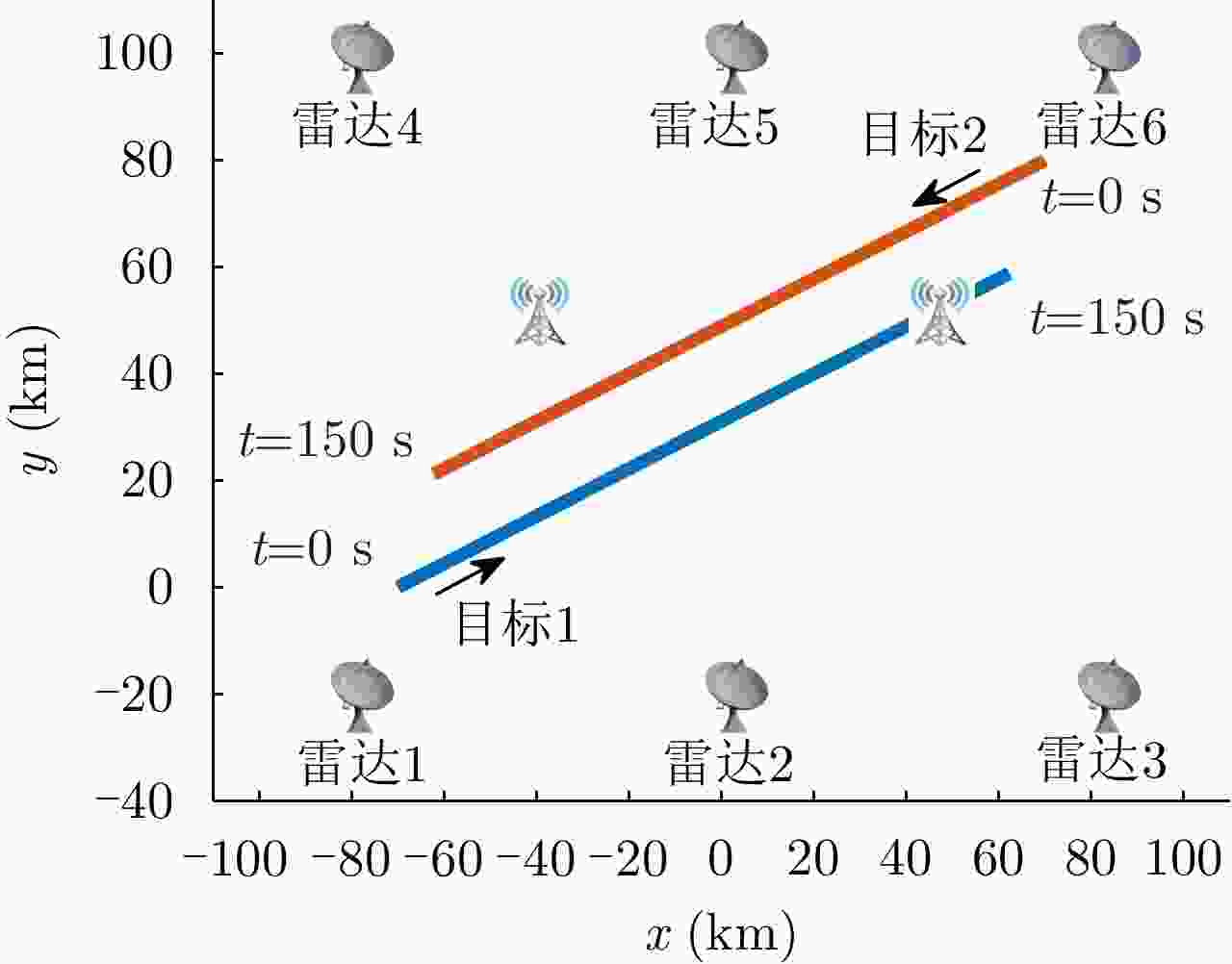
 下载:
下载:
